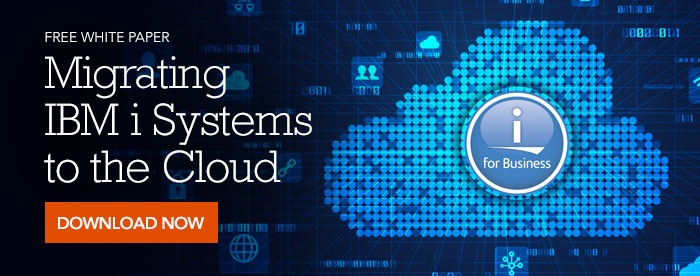There are myriad benefits to moving IBM i systems and business applications to the cloud including agility, scalability, ease of maintenance, and cost-efficiency. Yet for many businesses, migrating systems and applications to the cloud can be a complex decision with many factors to consider. That’s why at CloudFirst, we’ve compiled a list of the top reasons for migrating your IBM i systems to the cloud. From cloud backup to near real-time replication, there are many services and tools available to make the migration process easier than you might expect.
Business Reasons:
IBM i cloud migration provides three key benefits to your business:
- Security, Governance, and Availability— Cloud providers will ensure that you are fully compliant with all requirements for your IBM i systems. This includes the Data Centers, where Power system hardware resides. Cloud Data Centers provide redundant or fault-tolerant systems for power, HVAC, fire suppression, telecommunication lines, and 24/7 security, while ensuring that availability remains high.
- Lower Data Center Operating Costs— Another advantage to migrating IBM i systems to the cloud is that Data Center costs are greatly reduced, or eliminated altogether. Many businesses have already migrated their Windows-based applications to the cloud, including email to Office365, personal directories to OneDrive, and Microsoft applications to AWS or Azure. When you migrate your IBM Power system and Microsoft servers to the cloud, you reduce your local equipment requirements and you may also be able to convert your Data Center to a Data Closet, where all users will need onsite is Internet connectivity.
- Save by Converting Capital Expenditures (CAPEX) into Operating Expenses (OPEX)— Migrating your IBM i systems to the cloud can save considerably over the long run by shifting from CAPEX to OPEX. Most businesses outgrow their Power hardware in three to five years, requiring an upgrade and CAPEX approval process. This upgrade cycle is expensive and capital-intensive where cloud-hosted with an OPEX model offers predictable expenses with flexible growth.
Staffing & Expertise Reasons:
IBM i migration lets you capitalize on the vendor’s IBM i operational staffing and expertise; that takes the burden off your IBM i operational staff. Make sure your cloud provider is a certified IBM i business partner and will handle all Power system and IBM i OS administration and maintenance, including:
- Power system machine configuration
- IBM i, AIX and Linux partition creation
- CPU, disk and memory setup and upgrades
- Hardware and OS upgrades, technology refreshes, PTFs and maintenance
Additionally, your vendor can attend to your backup, restore, and high-availability needs (usually under separate contracts).
Technology Reasons:
Moving IBM i applications to the cloud provides multiple benefits:
- IBM i hosting offered as IaaS— Migrating to the cloud allows businesses to move their IBM i servers to Infrastructure as a Service (IaaS) installations. IaaS providers offer the systems and tools for migrations as well as the infrastructure needed for outside users to access the IBM i system. Some cloud providers, like CloudFirst, can also host Windows, AIX and Linux servers for you if needed.
- Scalability— Cloud providers can add disk, memory, or CPU capacity to IBM i servers rapidly on demand. When needed, temporary increases can be activated, then removed, such as in the run-up to and the aftermath of the holiday season. Scaling systems on-premises can take several weeks and require ordering and installing extra disks, memory, or CPUs.
- Cloud Backup and Recovery— Another bonus to cloud migration: the availability of backup and restore services that move away from legacy tapes. Encrypted, redundant backups are stored in at least two separate locations. Customers can manage backup schedules and retention requirements allowing the restoration of data from any point in time.
- Monitoring— Some cloud providers offer IBM i 24×7 system monitoring for system health, application errors, and service level agreement (SLA) compliance. Cloud monitoring services can replace more expensive third-party monitoring packages.
- Quickly create IBM i, Windows, AIX, and Linux Cloud Servers— Companion servers like test systems, quality assurance, development and front end Web servers can easily be added or migrated to the same IaaS environment.
- High availability (HA)— Enterprise-level, host-based and SAN-based replication with role switching are available and have defined SLAs for RPO and RTO requirements.
- Disaster Recovery as a Service (DRaaS)— In case of disaster, DRaaS ensures that servers can quickly failover to a spare virtual server. System recovery can occur up to ten times faster using DRaaS cloud recovery versus standard system recovery techniques and some providers include this functionality as part of the solution.
While migrating your data and business apps to the cloud can seem daunting, partnering with the certified IBM i experts at CloudFirst will make all the difference. We will work with you every step of the way to ensure that your migration effort is seamless, efficient, and achieves the short-term and long-range goals you’ve set for your business. Contact us today for a risk-free readiness assessment on moving your business to the next level of storage excellence and data protection on the cloud.


